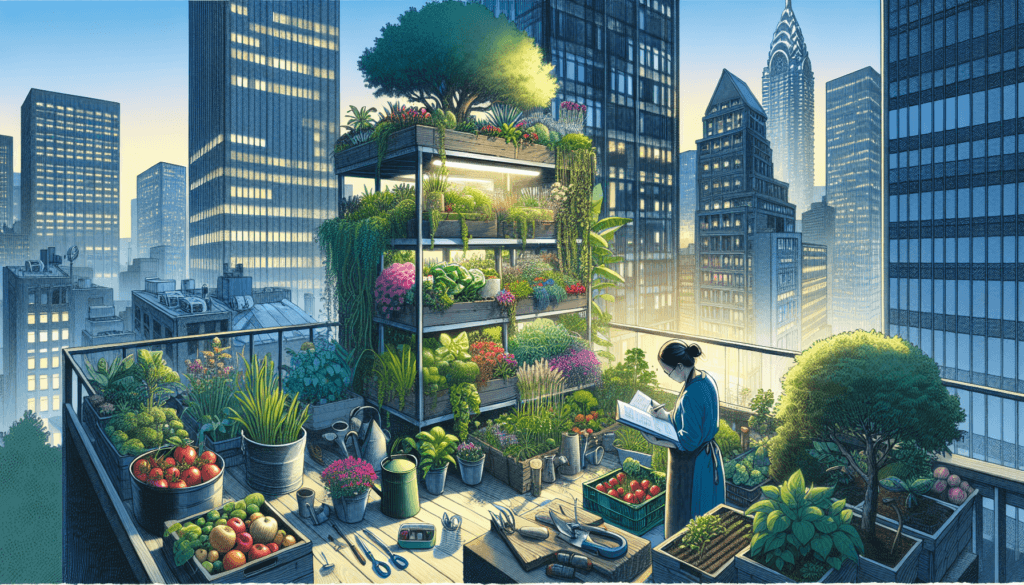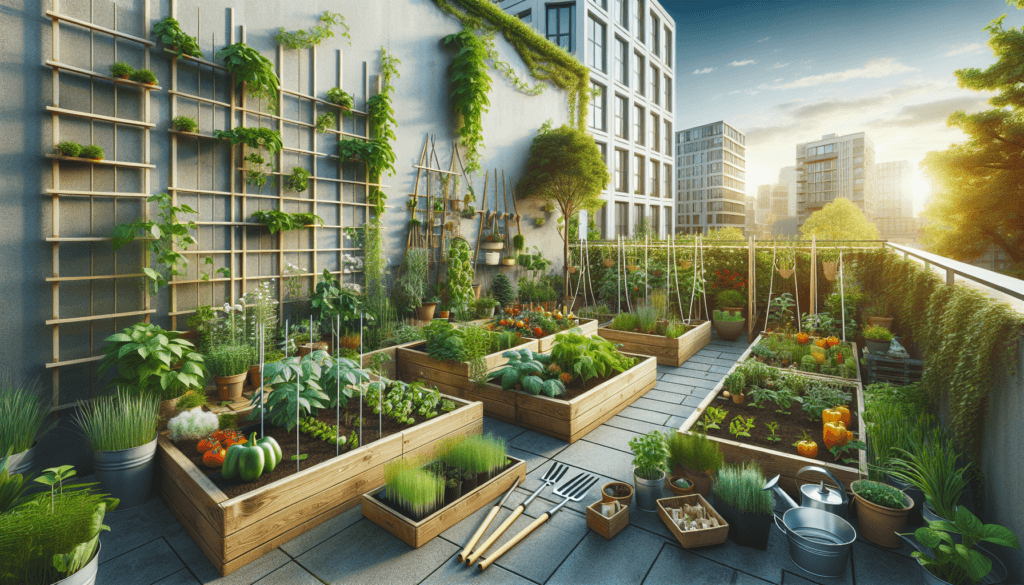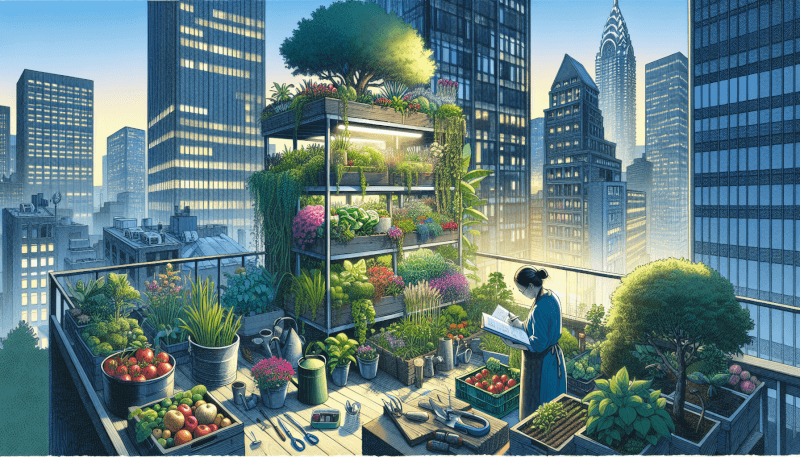Are you eager to transform your urban space into a beautiful and thriving garden? Look no further! This article is packed with valuable tips and advice to help beginners embark on their DIY urban gardening journey. From selecting the right plants for your space to maximizing your limited resources, we’ve got you covered. So grab your gardening gloves and get ready to unleash your green thumb!

Choosing the Right Location
When starting an urban garden, one of the first things you need to consider is choosing the right location. The success of your garden greatly depends on finding a suitable space that meets the needs of your plants. Here are some factors to consider when selecting a location for your urban garden.
Consider available space
Urban gardening often means working with limited space, so it’s important to make the most of what you have. Look for areas such as balconies, rooftops, or even window sills that receive adequate sunlight and have enough room to accommodate your plants. Take into account the size and number of plants you intend to grow to ensure that the available space can accommodate their growth.
Evaluate sunlight exposure
Plants need sunlight to thrive, so it’s crucial to assess the amount of sunlight your chosen location receives. Ideally, you want a spot with at least six hours of direct sunlight each day. Observe the area at different times of the day to see how the sunlight hits it. If the space doesn’t receive enough sunlight, you may need to consider alternative gardening methods like using grow lights or selecting shade-tolerant plants.
Assess the soil quality
Another important factor to consider when choosing a location is the quality of the soil. Take a sample of the soil and check for its texture, draining capacity, and nutrient content. If the soil is compacted, clayey, or lacks essential nutrients, you may need to amend it to create a hospitable environment for your plants. Alternatively, you can opt for container gardening, where you have more control over the soil composition.
Selecting Suitable Plants
Once you have a suitable location, it’s time to choose the right plants for your urban garden. Urban environments often come with unique challenges such as limited space and exposure to pollution, so selecting plants that can thrive in these conditions is crucial for a successful garden.
Research plants that thrive in urban environments
When selecting plants for your urban garden, it’s essential to choose varieties that are known to thrive in urban environments. Look for plants that have a high tolerance for pollution, compact growth habits, and low water requirements. Some commonly recommended plants for urban gardens include herbs like basil and rosemary, salad greens like lettuce and arugula, and compact fruiting plants like cherry tomatoes and strawberries.
Determine the seasonality of plants
Consider the seasonality of the plants you plan to grow. Some plants are better suited for cool weather, while others prefer warmer temperatures. Knowing the preferred growing seasons of your chosen plants will help you plan your garden accordingly and ensure that you provide the right conditions for their growth.
Consider the space requirements of each plant
Before selecting plants, it’s essential to consider the space requirements of each variety. Some plants, like sprawling zucchini or pumpkin plants, require a large growing area, while others, like compact herbs or microgreens, can easily thrive in smaller spaces. Make sure you have enough room to accommodate the mature size of each plant, or consider using trellises or vertical gardening techniques to maximize your space.

Preparing the Soil
Properly preparing the soil is key to creating a healthy and nutrient-rich environment for your plants. This step ensures that your plants can access the essential nutrients they need for growth and helps promote optimal root development.
Remove any existing weeds or debris
Before planting, it’s important to clear the area of any existing weeds or debris. Weeds can compete with your plants for nutrients and water, hindering their growth. Remove any large stones, sticks, or other debris that may impede root penetration or provide a breeding ground for pests.
Loosen the soil for better drainage
To ensure proper drainage and root development, it’s crucial to loosen the soil. Use a garden fork or a tiller to break up any compacted areas and create a loose and aerated planting bed. Loose soil allows water to penetrate deeper into the ground and prevents the formation of waterlogged areas that can result in root rot.
Amend the soil with compost or organic matter
To improve the fertility and nutrient content of the soil, consider amending it with compost or other organic matter. Compost adds valuable organic material, improves soil structure, and enhances nutrient availability for your plants. Mix in a generous amount of compost or organic matter into the planting bed to enrich the soil and provide a healthy growing environment for your plants.
Container Gardening
If you have limited space or unfavorable soil conditions, container gardening can be an excellent option for urban gardeners. Container gardening allows you to grow plants in pots, planters, or other containers, offering flexibility and mobility for your garden.
Choose appropriate containers
When selecting containers for your urban garden, there are a few important factors to consider. Look for containers that have drainage holes to prevent waterlogging. The size of the container should be adequate to accommodate the growth of your chosen plants. Ensure that the material of the container is suitable for your climate and aesthetic preferences. Options include terracotta pots, plastic containers, or even repurposed items like buckets or old tires.
Ensure proper drainage
Proper drainage is crucial for container gardening as it prevents excess water from pooling at the bottom of the container and causing root rot. Place a layer of stones or broken pottery at the bottom of the container to create a drainage layer. Then, fill the container with high-quality potting soil, leaving enough space for the plant’s root system and sufficient room for watering.
Use quality potting soil
Choosing the right potting soil is essential for the success of your container garden. Potting mixes are specifically formulated to provide adequate drainage while retaining enough moisture for plant roots. Look for a high-quality potting mix that is lightweight, well-aerated, and contains organic matter. Avoid using garden soil or heavy clay soil in containers, as they can lead to poor drainage and hinder plant growth.

Watering Techniques
Proper watering is essential for maintaining a healthy and thriving urban garden. Overwatering or underwatering can both have detrimental effects on your plants, so it’s important to establish a watering routine and use the correct techniques.
Establish a watering schedule
Establishing a consistent watering schedule helps ensure that your plants receive the right amount of water. The frequency of watering will depend on various factors such as the plant’s water requirements, the climate, and the soil type. As a general rule of thumb, check the moisture level of the soil by inserting your finger an inch deep. If the soil feels dry, it’s time to water, but if it feels moist, you can hold off for another day or two.
Use the right irrigation method
There are several irrigation methods you can use for your urban garden, each with its advantages and considerations. For larger containers or garden beds, drip irrigation systems provide a convenient and efficient way to water your plants. Watering cans or hose attachments with a gentle spray nozzle are suitable for smaller gardens. Avoid using a high-pressure hose, as it can damage delicate plant roots and disturb the soil.
Monitor moisture levels
Regularly monitoring the moisture levels of the soil is crucial to ensure your plants receive adequate hydration. Be mindful of under or overwatering and make adjustments as needed. The moisture level may vary depending on factors such as weather conditions, plant age, and growth stage. Some plants prefer slightly drier conditions, while others require consistently moist soil. Pay attention to any signs of water stress, such as wilting or yellowing leaves, and adjust your watering routine accordingly.
Fertilizing
To provide your plants with the necessary nutrients for healthy growth, it’s important to fertilize them regularly. Fertilizers help replenish essential nutrients in the soil and promote robust plant development.
Understand the nutritional needs of your plants
Different plants have different nutritional requirements, so it’s important to understand the specific needs of the plants you are growing. Nitrogen, phosphorus, and potassium are the primary macronutrients, but plants also require micronutrients such as iron, manganese, and zinc. Consider conducting a soil test to determine the nutrient levels in your soil and adjust your fertilization plan accordingly.
Choose organic or synthetic fertilizers
There are two main types of fertilizers available: organic and synthetic. Organic fertilizers are derived from natural sources, such as compost, manure, or bone meal. They release nutrients slowly and improve soil health over time. Synthetic fertilizers, on the other hand, are chemically formulated and provide a quick release of nutrients. Consider your gardening philosophy, preferences, and the specific needs of your plants when deciding which type of fertilizer to use.
Apply fertilizers correctly
To ensure that your plants receive an adequate amount of nutrients without causing harm or pollution, it’s important to apply fertilizers correctly. Follow the recommended dosage on the fertilizer package and avoid overfertilization, as it can lead to nutrient imbalances and harm your plants. Apply fertilizers evenly around the root zone, keeping a safe distance from the plant’s stem or foliage to prevent burning.

Pest and Disease Management
While gardening provides many joys, it also comes with the challenge of managing pests and diseases that can damage your plants. Implementing an effective pest and disease management strategy is crucial to safeguard your urban garden and promote plant health.
Identify common pests and diseases
Be familiar with the common pests and diseases that can affect your plants. Aphids, mealybugs, slugs, and snails are some pests that commonly infest urban gardens. Diseases such as powdery mildew, blight, or fungal infections can also pose a threat to your plants. Regularly inspect your plants for any signs of infestation or disease and take prompt action to mitigate damage.
Implement preventive measures
Prevention is key when it comes to managing pests and diseases in your urban garden. Start by practicing good garden hygiene, such as regularly removing dead leaves and debris that can harbor pests or diseases. Keep your plants healthy by providing adequate watering, proper fertilization, and optimal sunlight exposure. Consider using physical barriers like netting or row covers to protect your plants from pests.
Consider natural pest control methods
In addition to preventive measures, there are several natural pest control methods you can use in your urban garden. Introduce beneficial insects like ladybugs or lacewings, which feed on common garden pests. Use organic pest control products like neem oil or insecticidal soaps, which are effective against many pests and pose minimal harm to beneficial insects or the environment. Crop rotation and interplanting with pest-repellent plants can also help deter pests.
Pruning and Harvesting
Pruning and harvesting are important tasks that promote healthy growth and ensure a bountiful harvest in your urban garden. Regular pruning helps shape plants, remove diseased or damaged parts, and encourages new growth.
Learn proper pruning techniques
Each plant has unique pruning requirements, so it’s important to learn the proper pruning techniques for the plants in your garden. Remove dead or diseased branches, and prune back overgrown areas to encourage air circulation and prevent the growth of mold or fungal infections. Pruning also helps manage the size and shape of your plants, ensuring they fit within the available space while maintaining their health and productivity.
Harvest crops at the right time
Timing is critical when it comes to harvesting your crops. Harvesting too early may result in underdeveloped produce, while waiting too long may cause the fruits or vegetables to become overripe or lose their flavor. Refer to seed packets, gardening guides, or online resources to learn the optimal harvesting time for each plant. Harvesting regularly also encourages plants to continue producing throughout the growing season.
Promote plant growth through pruning
Pruning can also be used to promote plant growth and increase productivity. Strategic pruning helps redirect the plant’s energy towards essential areas, such as fruit production or flower development. Pinching off the tips of herbs or vegetables like basil or peppers can encourage bushier growth and more abundant harvests. By pruning with purpose, you can shape your plants, maximize their yield, and enhance the overall health of your urban garden.

Vertical Gardening
Vertical gardening is an excellent technique for maximizing space in your urban garden. It involves growing plants vertically, utilizing walls, trellises, or other structures to support their growth. Vertical gardening not only saves space but also creates a visually appealing and vibrant garden environment.
Utilize vertical space effectively
When practicing vertical gardening, it’s important to utilize vertical space effectively. Install trellises, stakes, or wall-mounted planters to support climbing plants and vines. Grow compact plants like herbs or leafy greens in tiered planters or vertical towers. By thinking vertically, you can significantly increase the number of plants you can grow in a limited space.
Choose suitable climbing plants
Selecting suitable climbing plants is crucial for successful vertical gardening. Look for varieties that have climbing or trailing growth habits, such as cucumbers, tomatoes, beans, or ivy. Consider the weight and support requirements of each plant and choose structures that can accommodate their growth. Ensure that the location provides enough sunlight and ventilation for the climbing plants to thrive.
Build or purchase vertical garden structures
There are various options for creating vertical garden structures. You can build your own trellises using bamboo stakes, wire mesh, or wooden pallets. Alternatively, you can purchase ready-made structures like wall-mounted planters, vertical towers, or hanging baskets. Consider the aesthetics, space requirements, and durability of the structures when choosing or building your vertical garden.
Sustainability and Eco-friendly Practices
Practicing sustainability and adopting eco-friendly practices in your urban garden not only benefits your plants but also helps minimize your environmental impact. Consider implementing the following practices to create a more sustainable and eco-friendly garden.
Practice composting
Composting is a simple and effective way to reduce waste and create nutrient-rich soil for your urban garden. Set up a compost bin or pile in an area of your garden and add organic kitchen waste, yard trimmings, and plant debris. Regularly turn the compost to speed up the decomposition process. The resulting compost can be used as a natural fertilizer to enrich your soil and promote healthy plant growth.
Use rainwater harvesting
Conserving water is an important aspect of sustainable gardening. Consider setting up a rainwater harvesting system to collect and store rainwater for irrigation purposes. Place barrels or containers under downspouts to capture rainwater runoff. When watering your plants, use this collected rainwater instead of tap water. Rainwater is free from chemicals found in tap water and provides plants with the ideal pH balance.
Implement companion planting
Companion planting is an eco-friendly practice that involves planting compatible species together to enhance growth and deter pests. Certain plants have natural abilities to repel insects or attract beneficial insects. Planting marigolds near vegetables, for example, can help repel aphids and nematodes. Research companion planting combinations that work well in your urban garden and experiment to find the best combinations for your plants.
In conclusion, urban gardening offers a rewarding experience for beginners and holds the potential to transform small spaces into thriving green oases. By choosing the right location, selecting suitable plants, preparing the soil, practicing container gardening, employing proper watering techniques, fertilizing appropriately, managing pests and diseases, pruning and harvesting effectively, exploring vertical gardening, and adopting sustainable practices, you can create a successful and vibrant urban garden. Remember, patience, observation, and a willingness to learn are key to developing your green thumb and enjoying the beauty and bounty of your urban oasis. Happy gardening!


